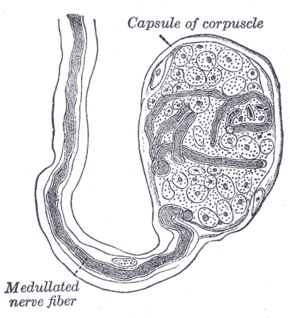Biology:Bulboid corpuscle
| Bulboid corpuscle | |
|---|---|
 End-bulb of Krause. | |
| Details | |
| Identifiers | |
| Latin | corpuscula bulboideum |
| Anatomical terminology | |
The bulboid corpuscles (end-bulbs of Krause) are cutaneous receptors in the human body.
The end-bulbs of Krause were named after the German anatomist Wilhelm Krause (1833–1910).[1][2]
Function
The end-bulbs of Krause were thought to be thermoreceptors, sensing cold temperatures, but their function remained unknown.[3] Recently optogenetic studies revealed their role in sexual stimulation and mating behavior in mice:
"Optogenetic activation of male Krause corpuscle afferent terminals evoked penile erection, while genetic ablation of Krause corpuscles impaired intromission and ejaculation of males as well as reduced sexual receptivity of females. Thus, Krause corpuscles, which are particularly dense in the clitoris, are vibrotactile sensors crucial for normal sexual behavior."[4]
Structure
They are minute cylindrical or oval bodies, consisting of a capsule formed by the expansion of the connective-tissue sheath of a medullated fiber, and containing a soft semifluid core in which the axis-cylinder terminates either in a bulbous extremity or in a coiled-up plexiform mass.
Location
End-bulbs are found in the conjunctiva of the eye (where they are spheroidal in shape in humans, but cylindrical in most other animals), in the mucous membrane of the lips and tongue, and in the epineurium of nerve trunks.
They are also found in the penis and the clitoris and have received the name of genital corpuscles;[5] in these situations they have a mulberry-like appearance, being constricted by connective-tissue septa into from two to six knob-like masses.[citation needed]
In the synovial membranes of certain joints, e. g., those of the fingers, rounded or oval end-bulbs occur, and are designated articular end-bulbs.
References
- ↑ synd/2425 at Who Named It?
- ↑ Krause, W. (1860) (in de). Die terminalen Körperchen der einfach sensiblen Nerven. Hannover. OCLC 488510746, 14844647, 224361622.[page needed]
- ↑ Gartner, Leslie P. (2015). Textbook of Histology. Elsevier Health Sciences. ISBN 978-0-323-39068-2. OCLC 938048317.[page needed]
- ↑ Qi, Lijun; Iskols, Michael; Handler, Annie; Ginty, David D. (2023). "Krause corpuscles of the genitalia are vibrotactile sensors required for normal sexual behavior". bioRxiv. doi:10.1101/2023.06.14.545006. PMID 37398085.
- ↑ Cold, C.J.; Taylor, J.R. (27 May 2002). "The prepuce". BJU International 83 (S1): 34–44. doi:10.1046/j.1464-410x.1999.0830s1034.x. PMID 10349413.
External links
 |

